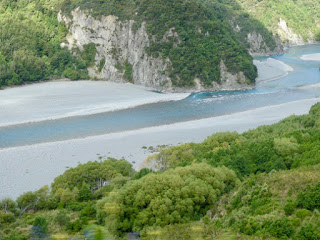After spending the morning exploring central Greymouth, having "elevenies" at a local coffee shop, and buying a few snacks for the afternoon, we caught the Trans Alpine Express for a reverse trip from yesterday, back to Christchurch.
The first set of photos were taken while strolling around Greymouth:
· Four WWII German U-boat engines were used to generate electricity in Dobson (named for the brother of Arthur Dobson (Arthur’s Pass), and the local folks could feel the vibrations.
· The Grey River is a major river running from Christabel Lake at the divide to the Tasman Sea.
· Coal mine disaster occurred near Stillwater next to river (Brunner) where 65 men died; all disasters caused by methane explosions. Miners from socialist party and went on strike for a 30-minute lunch period (over a 15-minute break), ultimately pushing for an 8-hour work day.
· Greymouth is known historically for gold, coal, and timber.
· Gold rush on the West Coast began 1864; 29,000 miners came, some were the CA 49’ers.
· Arnold River is a short river from Lake Brunner to the Grey River, known for fly fishing. Jet boats are banned on the river.
· Thomas Brunner, a surveyor, was the first European to view the lake named after him.
· Alpine Fault earthquakes average period is 330 years, ranging between 140 to 500 years. The last major earthquake was 1710.
· Sawmills were frequent in number between Moana and Inchbonnie, springing up to feed the gold rush towns. The forests are known as “the Bush.”
· Red pine is a favored lumber before WWII. Logging is mostly over and restricted. Present day logging is on introduced species.
· The Otira Tunnel was the 7th longest tunnel in the world when it opened. But it is now 45th longest. There are two longer tunnels in NZ. Most of the longest are under the European Alps.
· Arthur's Pass (where the highway crosses) is at 3,000 feet, but the rail tunnel travels under it and emerges at Arthur Pass Station. The station is at 2,418 feet, the highest point for the rail line. The tunnel rises 820 feet.
And finally some more photos:




















The scenery is impressive; your train ride had better views than ours from NJ to VA. ET
ReplyDelete"Public Art" is interesting ! I love your descriptions of all the places you visit ! Thank You for sharing JR
ReplyDelete